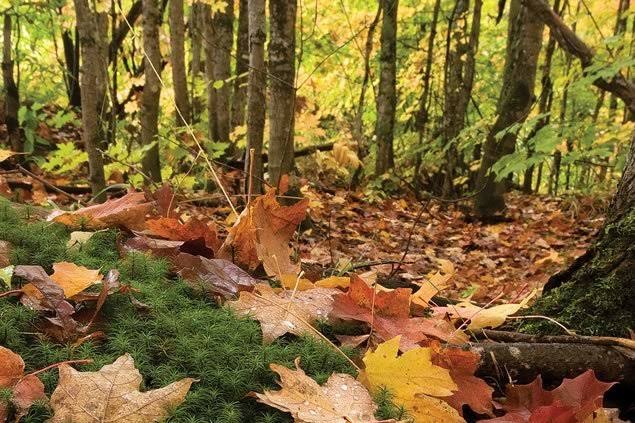When trees decompose, they release carbon dioxide (CO2) into the atmosphere, contributing to the carbon cycle. This process begins when a tree dies, whether from natural causes, disease, or logging. Microorganisms such as bacteria and fungi break down the tree's organic matter, releasing stored carbon in the form of CO2. This decomposition process is a natural part of the carbon cycle, where carbon stored in trees during their growth is returned to the atmosphere. Understanding the mechanisms and impacts of carbon release from decomposing trees is crucial in managing forests and mitigating climate change.
The Decomposition Process
Decomposition of trees begins when a tree dies and starts to break down. This process is primarily driven by microorganisms, including bacteria and fungi, which consume the organic material. These organisms break down complex organic compounds, such as cellulose and lignin, into simpler molecules. During this metabolic process, carbon stored in the tree's tissues is converted into carbon dioxide, which is then released into the atmosphere. The rate of decomposition and carbon release depends on various factors, including the tree species, environmental conditions (temperature, humidity), and the presence of decomposers.
Carbon Storage in Trees
Trees are significant carbon sinks, storing large amounts of carbon in their biomass through the process of photosynthesis. During their growth, trees absorb CO2 from the atmosphere and convert it into organic carbon, which is stored in their trunks, branches, leaves, and roots. When a tree dies, this stored carbon is gradually released back into the atmosphere through decomposition. The balance between carbon storage and release is critical in maintaining atmospheric CO2 levels and influencing global climate patterns.
Role of Microorganisms
Microorganisms play a crucial role in the decomposition process. Fungi are particularly important in breaking down lignin, a complex organic polymer that provides structural support to plants and is difficult to decompose. Bacteria, on the other hand, are more efficient at decomposing cellulose and other simpler compounds. The activity of these microorganisms is influenced by environmental factors such as temperature, moisture, and oxygen availability. Warmer temperatures and higher moisture levels typically accelerate microbial activity and the decomposition process, leading to faster carbon release.
Environmental Impact of Carbon Release
The release of carbon from decomposing trees contributes to the greenhouse gas concentrations in the atmosphere. CO2 is a major greenhouse gas that traps heat in the earth’s atmosphere, contributing to global warming and climate change. Forest ecosystems play a dual role in this context; while living forests act as carbon sinks, dead and decomposing trees can become sources of carbon emissions. Managing forests to balance these dynamics is crucial in efforts to mitigate climate change.
Decomposition Rates and Climate Change
Climate change itself can affect the rate of tree decomposition and subsequent carbon release. Warmer global temperatures and changing precipitation patterns can alter microbial activity and decomposition rates. For instance, increased temperatures can enhance the metabolic rates of decomposers, leading to faster carbon release. Additionally, extreme weather events such as storms and wildfires can cause large-scale tree mortality, resulting in significant carbon emissions as the dead trees decompose.
Forest Management and Carbon Sequestration
Effective forest management practices are essential in enhancing carbon sequestration and reducing carbon emissions from decomposing trees. Practices such as reforestation, afforestation, and sustainable logging can help maintain and increase forest carbon stocks. Additionally, deadwood management, including leaving some dead trees for biodiversity benefits while removing others to reduce fire risk, can help balance carbon storage and release. Understanding the decomposition process and its impact on carbon cycles informs these management strategies.
Soil Carbon and Decomposition
While much focus is placed on above-ground decomposition, soil carbon dynamics are also critical. As trees decompose, not all carbon is immediately released into the atmosphere; a significant portion can be transferred into the soil. Soil organic matter, formed from decomposed plant and animal materials, represents a major carbon pool. The interaction between soil microorganisms and decomposing tree material influences the long-term sequestration of carbon in soils. Healthy, carbon-rich soils are vital for maintaining overall forest carbon balance and ecosystem health.
Measuring and Modeling Carbon Release
Accurately measuring and modeling carbon release from decomposing trees is challenging but essential for understanding and managing carbon cycles. Scientists use a combination of field measurements, laboratory studies, and remote sensing technology to estimate carbon release. Modeling tools, such as carbon flux models and decomposition models, help predict how different factors influence carbon dynamics. These models are critical for informing climate policy and forest management decisions.
Mitigation Strategies
To mitigate the impact of carbon release from tree decomposition, various strategies can be employed. These include increasing forest cover through reforestation and afforestation projects, promoting practices that enhance forest health and resilience, and protecting existing forests from deforestation and degradation. Additionally, restoring degraded lands and implementing agroforestry practices can help sequester more carbon in vegetation and soils. Policies and incentives that support sustainable forest management are also crucial in reducing carbon emissions from decomposing trees.
Future Research Directions
Further research is needed to fully understand the complexities of carbon release from tree decomposition and its implications for the global carbon cycle. Areas of focus include the effects of climate change on decomposition rates, the role of different microbial communities in carbon cycling, and the long-term storage of carbon in soils. Improved modeling techniques and more comprehensive data collection will enhance our ability to predict and manage carbon dynamics in forest ecosystems.
Summary
The decomposition of trees is a natural process that plays a significant role in the carbon cycle, influencing atmospheric CO2 levels and climate change. By understanding the factors that drive decomposition and carbon release, and by implementing effective forest management practices, we can better manage carbon emissions and enhance the role of forests as vital carbon sinks in the fight against climate change.
